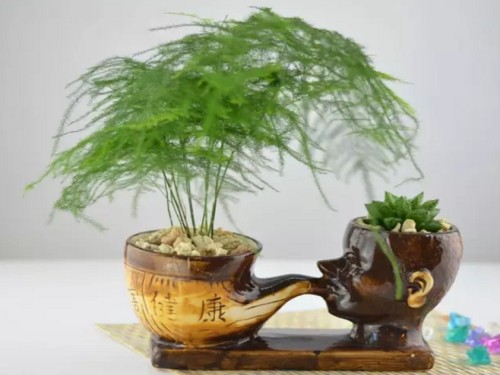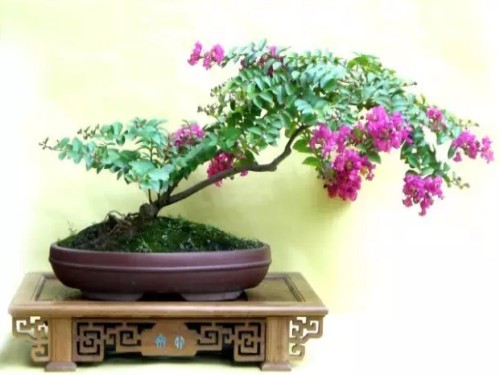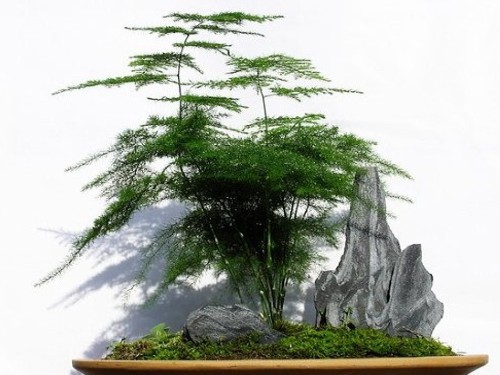How to shape asparagus-the modeling method of asparagus bonsai
Asparagus, also known as Pinus elliottii, Phyllostachys pubescens, Phyllostachys pubescens, is an evergreen foliage plant with high ornamental value. it is a plant of the genus asparagus of Liliaceae. The root of asparagus can be used as medicine and has the effect of treating acute tracheitis and relieving cough. It is mainly used to observe leaves in potted plants, and it is also an important leaf-cutting material.
Asparagus is one of the foliage flowers that people like to cultivate, its whole plant is green, the stems and branches are slender but tall and straight, and the leafy branches extend horizontally like triangles, degenerating into membranous scaly leaves, which are attached to the branches like down. Because its stem is clustered from the root, the height is different, so that the cloud-like branches and leaves are stacked one after another, so it is also known as cloud bamboo.

How to improve the ornamental value of asparagus? First of all, we should start with the shaping and pruning of asparagus. The methods of pruning and shaping of asparagus are briefly introduced as follows:
1. Basin control method
The ratio of flowerpot to plant size should be controlled at 1:3, which can limit root growth and keep plant size unchanged.
2. Remove the growing point in time
When the new buds grow to 2-3 years old, the growing points are removed to promote the regeneration of branches and leaves on the stem, and to control their non-growing vines, so that the branches and leaves flatten out, and the plant type continues to plump.
3. Make full use of the phototaxis of asparagus.
Turning the direction of the flowerpot at the right time can modify the growth shape of branches and leaves and keep the plant type plump and elegant.
4. Object shielding method
Use a piece of hard paper to press the branches and leaves or block the sun, so that when the branches and leaves grow, they will turn or bend when they encounter objects, so as to achieve the purpose of modeling.
5. Comprehensive application of several plastic methods.
(1) Tower shaping
Choose 2-3 tall and straight and beautiful stems as the main peak, remove each growing point on the stem, set the plant height to 30-35 years, and the rest of the branches and new stems should not be higher than the main peak. For new buds, the thickness of their stems can be used to determine whether or not to remove the growing point. If the stem is thicker than the stem of the main peak, it should be removed, and if the stem is thinner than the stem of the main peak, it is not necessary to pick and let it grow. At the same time, the conjugate shielding method and the phototaxis of the plant are needed to adjust the plant type continuously.
(2) double-cluster plastic surgery
Plant one high and one low asparagus in the basin, the high one is about 30 years old, the low one is about 18 years old, and then reshape it according to the tower style during the growth period.
(3) Natural plastic surgery
Based on the plant type of natural growth of asparagus, the basic methods such as removing the growing point, shading and making use of its phototaxis can stretch the branches and leaves and give people a natural sense of beauty.
Due to the limited living conditions, most families still want the asparagus at home to maintain a graceful and graceful posture, which requires special maintenance methods to control the growth of its climbing branches.
The first is pruning and topping. The climbing branch of asparagus is characterized by long, thick and rapid growth, and there is no sign of leaf when it is pulled out above 20 cm (the standard name is "lateral leafy branch"). Once this kind of branch is found, the top branch can be trimmed at the desired leaf height (usually 10~15cm), so that the plant loses its apical advantage, and the lateral branches will sprout in the first section below the cut, and then show the leaves of Biyun.
The second is to control water and fertilizer. Excessive water and fertilizer is also an important factor in the "barbaric growth" of asparagus. Asparagus in the root of the "bamboo shoots", should be deducted water to stop fertilizer, to slightly wilt for the degree, otherwise it is easy to "crazy growth" and not to spread leaves. Only when the "bamboo shoot" changes from tender to old and the color changes from light to dark (this is a sign of Lignification, and the longitudinal growth of the plant stem stagnates or slows down once the plant stem is lignified), it can gradually add water and fertilizer to spread its leaves; wait for it to pull out the next batch of "bamboo shoots" and then do the same.
The third is reasonable lighting. Many flower friends mistakenly think that asparagus likes shade, so they stay indoors for a long time. In fact, asparagus is most suitable to grow under semi-shade or weak light conditions, and can even withstand short-term exposure. Generally, it can accept sunlight except that it needs shade after 9 am in midsummer from July to September. On the contrary, if there is not enough light, it will sprout disorganized climbing branches because of "looking for light".
In addition, there is a "folk prescription" is to avoid ramets. Like Acorus calamus, asparagus is "suitable for cutting but not suitable for division", especially as a miniature bonsai grower. Once the growth of Chinese bamboo is too dense, the excess branches should be cut off thoroughly from the base instead of ramet. Frequent pruning can make the plant type plump and compact, while frequent ramets will only accelerate the aging of the plant, make the branches grow and make the seedlings lose their feet.
However, the above-mentioned methods are only "temporary rather than permanent".
Because as mentioned earlier, asparagus belongs to Fujimoto, the emergence of climbing branches in more than two-year-old seedlings is also a normal physiological phenomenon. We should also follow its natural law, if the living room conditions permit, might as well guide according to the situation: when it begins to "open teeth and claws", you can build the scaffolding and let it climb up, and you can also appreciate its graceful posture of winding vines and soft branches. Don't have some fun.
After climbing the vine, asparagus should strengthen the light, increase the application of phosphorus and potassium fertilizer, pay attention to shading in summer and heat preservation in winter to make it blossom and bear fruit. It can be "handed down from generation to generation" by sowing every spring, and the sowing seedlings can be eliminated and renewed every 2 ~ 3 years. In this way, there are always a group of beautiful seedlings in the hands of no more than three years old, such as loose bamboo, not to worry about "living without bamboo".
Time: 2019-06-10 Click:
- Prev

How to trim crape myrtle bonsai
Crape myrtle is a very interesting flower tree, it has a characteristic: crape myrtle blossoms for a hundred days, gently caressing the branches and stems of the whole tree. Therefore, crape myrtle is also known as the itching tree. Crape myrtle has beautiful appearance, flexible branches and bright flowers, and blossoms in summer and autumn. It is an important ornamental tree species in summer and autumn.
- Next

How to prune bonsai Phyllostachys pubescens
Asparagus is a perennial vine resident green herbaceous flower, which is called cloud bamboo, pine mountain grass and cloud bamboo mountain grass in some places. Although asparagus has the characteristic of evergreen for many years, if it is not pruned properly in maintenance, it will lead to the symptom of yellowing of branches and leaves and affect the ornamental effect. Asparagus grows longer and longer after it has been raised for a long time.
Related
- Fuxing push coffee new agricultural production and marketing class: lack of small-scale processing plants
- Jujube rice field leisure farm deep ploughing Yilan for five years to create a space for organic food and play
- Nongyu Farm-A trial of organic papaya for brave women with advanced technology
- Four points for attention in the prevention and control of diseases and insect pests of edible fungi
- How to add nutrient solution to Edible Fungi
- Is there any good way to control edible fungus mites?
- Open Inoculation Technology of Edible Fungi
- Is there any clever way to use fertilizer for edible fungus in winter?
- What agents are used to kill the pathogens of edible fungi in the mushroom shed?
- Rapid drying of Edible Fungi

